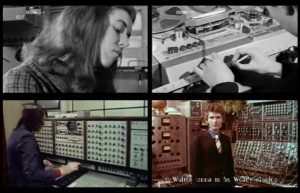Dan Deacon taking over fans' smartphones, making them part of the show
September 16, 2012Dan Deacon is taking over the smartphones of fans at his live performances to turn them into part of the show.
Fans attending a concert on the experimental artist’s current tour, which is promoting his recent album America, can download the app from the App Store and Google Play before they head to the venue. When the show starts, all phones running the app can be controlled using sonic prompts – in much the same way as the Chirp app we recently covered. The musician can then synchronize the crowd’s phones to display the same color and make the LED lights flash in time with each other as part of the light show. Perhaps most interestingly, the smartphones can also be made to emit sound, becoming an extra instrument for the musician to play.
The app offers a new way for the audience to become a part of the show – increasing engagement – and also exorcizes the stigma attached to fans holding their phone up at a concert.
Drum Phil, analogue drum sequencer built from modified reel-to-reel
September 14, 2012Source: http://www.booooooom.com/2012/09/05/made-of-imagination-homemade-instrument-submissions/
Drum Phil is an analogue drum sequencer built from a modified reel to reel tape player. Paper disks can be played with preprogrammed rhythms or the stylus mounted tape heads can be removed and used to manually tap out beats by touching the coloured dots. The data stored on credit cards and train tickets etc is what creates the sound.
Created by Ally Mobbs – Kyoto, Japan
Source: http://www.booooooom.com/2012/09/05/made-of-imagination-homemade-instrument-submissions/
The Alchemists of Sound, 2003 documentary about BBC Radiophonic Workshop
September 13, 2012Source: http://ubu.com/film/alchemists.html
The BBC's Radiophonic Workshop was set up in 1958, born out of a desire to create 'new kinds of sounds'. The Alchemists of Sound looks at this creative group from its inception, through its golden age when it was supplying music and effects for cult classics like Doctor Who, Blake's Seven and Hitchhiker's Guide To The Galaxy, and charts its fading away in 1995 when, due to budget cuts, it was no longer able to survive.
There are interviews with composers from the Workshop, as well as musicians and writers who have been inspired by the output. Great archive footage of the Workshop and its machinery is accompanied by excerpts of the, now cult, TV programmes that featured these sounds.
The Alchemists of Sound (2003)
Duration: 60 minutes
BBC Radiophonic Workshop
Director: Roger Pomphrey
Cast:
Oliver Postgate ... Narrator (voice)
Mark Ayres ... Himself
Milton Babbitt ... Himself (archive footage)
John Baker ... Himself (archive footage)
Desmond Briscoe ... Himself
David Cain ... Himself
Wendy Carlos ... Himself (archive footage) (as Walter Carlos)
Malcolm Clarke ... Himself
Delia Derbyshire ... Herself (archive footage)
Maddalena Fagandini ... Herself
Brian Hodgson ... Himself
Peter Kember ... Himself
Paddy Kingsland ... Himself
Roger Limb ... Himself
Dick Mills ... Himself
Robert Popper ... Himself
Peter Serafinowicz ... Himself
Adrian Utley ... Himself
Frazer Hines ... Jamie McCrimmon (archive footage) (uncredited)
Peter Jones ... The Book (voice) (archive footage) (uncredited)
Wendy Padbury ... Zoe Heriot (archive footage) (uncredited)
Patrick Troughton ... The Doctor (archive footage) (uncredited)
RECENT POSTS
- Danville To Glenmont
- TJ Evans Trail
- Blacklick Creek Trail
- Roberts Pass Trail
- Alum Creek Trail South
- Southern Half of the Hockhocking Adena Bikeway
- Hockhocking Adena Bikeway Northern-half
- Kokosing Gap Trail
- Adding Background Music to Puzzlescript Games
- Baby Zombie Chicken Jockey Java Minecraft Mod
- Raining Chickens Java Minecraft Mod
- Spawn a Pet Wolf Java Minecraft Mod
- Spigot Server for Java Minecraft Mods
- Python Classes to Javascript Classes
- JUnit Tests with Repl.it Teams for Education
- Canvas How to convert an old Quiz Question Bank to a new Quiz Item Bank
- Node Twitterbot Directions
- FogeyBot Thinks Twitter is the Worst
- Detecting Sentence Structure with Regex
- Game-based Learning Presentation
- Hello Jekyll
- Testing 123
- Grading Multi-Select Questions with Google Forms and Google Sheets
- Puzzlescript Rules
- Using Makey Makey to Teach Electricity
- Makey Makey + Scratch Video Game Projects
- Orbit Simulator
- Market game
- TwineFray: A Battle System for Twine
- Sundown
- Twine Games by Middle School Students
- Twine CSS
- Twine Music and Sound Effects from YouTube
- Twine Pictures, GIFs, and Background Images
- Twine Random Numbers
- Tutorial videos for Spreadsheet Functions and Formulas
- How to Program Twitterbots as an Intro to Computer Science
- Podcast Recommendations
- Coding Twitterbots with Middle School Students
- Educational Games on The Internet Archive
- Typing Games in Scratch
- Scratch Tutorial Videos
- Editing videos with Windows Movie Maker
- How to use iMovie for iPad
- Quick and easy DIY pressure plate switch for Makey Makey and Scratch
- Webcam Motion Pixel Art
- Flipped Classroom Scratch Programming Lessons
- BYOD Music Class Using OhioFi Games
- 3 Methods for Going Paperless in the Classroom
- Dodgeball Cat




